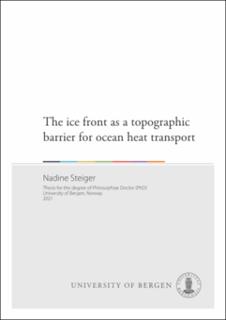The ice front as a topographic barrier for ocean heat transport
Doctoral thesis
Permanent lenke
https://hdl.handle.net/11250/2760582Utgivelsesdato
2021-06-28Metadata
Vis full innførselSamlinger
- Geophysical Institute [1198]
Sammendrag
Antarctic ice shelves are the link between the Southern Ocean and the Antarctic Ice Sheet. The floating ice shelves restrain the seaward flow of the grounded ice, which is balanced by iceberg calving and ocean-induced basal melting. An increase in oceanic heat flux towards the West Antarctic ice shelves during the last decades has caused the ice shelves to thin. Nevertheless, the observed melt rates are lower than expected from the oceanic heat available on the continental shelf, suggesting that not all the heat is used to melt the ice shelves. Ice shelves extend several hundred meters into the ocean and terminate with a vertical wall, the ice front, that poses a topographic barrier to the ocean heat transport towards the sub-ice shelf cavities. Little is known about the influence of the discontinuity in water column thickness on the southward currents that transport warm and dense Circumpolar Deep Water from north of the continental shelf towards the ice shelf cavities. This thesis improves our understanding of the ocean dynamics and the drivers of heat transport variability in the vicinity of the ice front, based on mooring observations in front of the Getz Ice Shelf in West Antarctica, laboratory experiments, and idealized numerical modelling.
From the mooring observations, we infer in Paper I that only a small fraction of the southward heat transport eventually reaches the Getz Ice Shelf cavity, due to the different response of the barotropic (depth-constant) and the baroclinic (depth-varying) components of the current to the ice front. The barotropic component is blocked and deflected at the ice front; only the baroclinic, bottom-intensified component enters the ice shelf cavity. Results from laboratory experiments on a rotating platform support these observations. The experiments show that the barotropic current follows lines of constant water column thickness and turns at the ice front, while the baroclinic, dense current follows lines of constant bed topography and enters the cavity without being influenced by the ice front.
The heat transport towards the Getz Ice Shelf cavity is additionally reduced by intermittent deepening of cold and fresh Winter Water towards the bottom, disrupting the southward flow of the warm Circumpolar Deep Water. We show in Paper II that the deepening of the Winter Water is triggered by easterly winds and coastal Ekman downwelling in about 100 km distance from the moorings. The signal appears to propagate westward towards the mooring site as a coastal trapped wave. While the cold Winter Water deepens at the ice front, the velocities at depth do no longer align with the bathymetry directed towards the cavity, but flow parallel to the ice front. The number of these events during each winter and the consequent reduction in heat transport depends on the number of strong wind events and the pre-conditioning of the water column.
In Paper III, we investigate the dynamics of an externally forced barotropic current colliding with an ice front, using idealized numerical model simulations. When the barotropic current reaches the ice front, most of the flow is deflected, in agreement with the observations in Paper I and the theory of geostrophy. A fraction of the barotropic flow over a sloping bottom can enter the ice shelf cavity depending on the ice shelf thickness and background stratification. In a non-stratified ocean, the change in water column thickness largely determines the volume flux into the cavity. The flow can pass the discontinuity because of ageostrophic processes and large vertical velocities as the water column squeezes into the cavity. The part of the flow that is blocked develops a narrow and fast current parallel to the ice front that causes high melt rates in the frontal region. In a stratified ocean, in contrast, vertical velocities at the ice front are suppressed, and the upper water column is unable to flow under the ice shelf. Consequently, most of the flow is blocked by the ice front.
The three papers in this thesis show that the vertical front of Antarctic ice shelves affect the transport of ocean heat into the underlying cavities. The deflection of ocean heat transport at the ice front is relevant for the basal melting of ice shelves. The amount of ocean heat delivered to the base of the ice shelves depends on the relative contribution of the barotropic and the baroclinic components, the vertical density structure of the water column, and the geometry of the ice shelf. Surface winds and sea ice growth modify the vertical structure of the water column and drive the variability in heat transport into the ice shelf cavity.
Består av
Paper I: Wåhlin, A.K., Steiger, N., Darelius, E., Assmann, K.M., Glessmer, M.S., Ha, H.K., Herraiz-Borreguero, L., Heuzé, C., Jenkins, A., Kim, T.W., Mazur, A.K., Sommeria, J., Viboud, S. (2020), Ice front blocking of ocean heat transport to an Antarctic ice shelf, Nature 578: 568–571. The article is not available in BORA due to publisher restrictions. The published version is available at: https://doi.org/10.1038/s41586-020-2014-5Paper II: Steiger, N., Darelius, E., Wåhlin, A. K., Assmann, K. M. Intermittent reduction in ocean heat transport into the Getz Ice Shelf cavity during strong wind events. The article is not available in BORA.
Paper III: Steiger, N., Darelius, E., Kimura, S., Patmore, R. D., Wåhlin, A. K. The dynamics of a barotropic current at an ice front. The article is not available in BORA.
